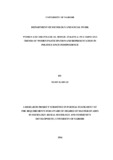| dc.description.abstract | Kenyan women constitute a vital national resource whose ideas, creativity and concerns for social cohesion can help bring about positive change in all spheres of the society. Even though a number of women have made great strides in politics in the country, women representation is far below the minimum one third public service requirement of Article 27(3) of the Constitution of Kenya 2010. The main objective of the study was to analyze the women and the political mosaic (patterns and trends) of women participation and representation in post-independence Kenya. Specifically, this study sought to; establish the patterns and trends of women participation in political leadership in post-independence Kenya parliament, examine the effectiveness of Constitution of Kenya 2010 in supporting women participation and representation in political process and to determine the perceived benefits and challenges of women participation and representation in post-independence Kenya.
This study used a qualitative research design. The study population comprised of all the women who have been involved in politics in post-independence Kenya parliament and county assembly. The study used a non-probability sampling technique whereby the study used purposive sampling to select 14 key informant interviewees guided by the geographical representation and the political periods. Similarly, the study purposively sampled 32 participants for focus group discussion. Participants for the FGD were drawn from two counties namely Nairobi to represent the urban region and Nyandarua to represent the rural region. The study used secondary data which was quantitative in nature and primary which was qualitative in nature. To collect secondary data, the study used a check list. To collect primary data, the study used a focus discussion group and a key informant interview guide. Specifically, the study held 4 focus discussion groups, 2 in Nairobi County and 2 in Nyandarua County. Each FGD comprised of 8 women who have been involved in politics. Further, the study conducted 7 interviews in each county.
The study concluded that women participation in political leadership in post-independence Kenya is very low compared to the demographic reality. The study concluded that there has been a gradual increase in the level of women representation in parliament. The study also concluded that women do not have a full understanding of the constitution since their responses were not in tandem with what the Constitution of Kenya 2010 states. It was evident that the new constitution has benefited women by improving their status even though they are faced with a myriad of challenges. | en_US |

